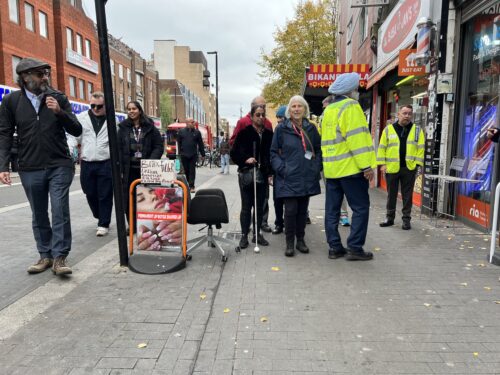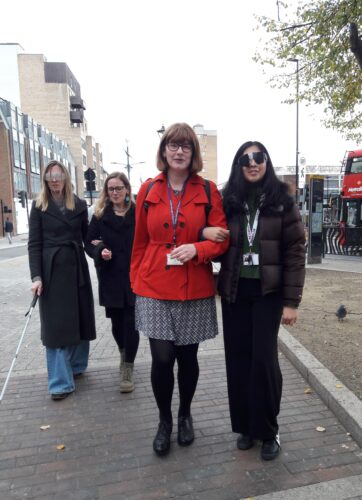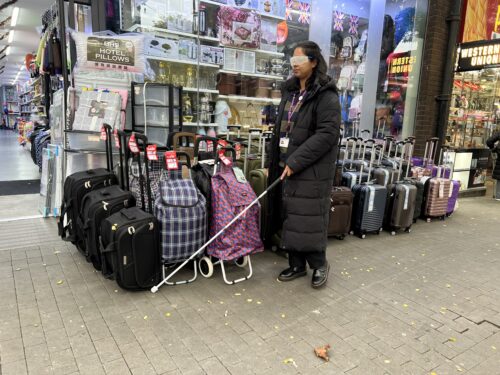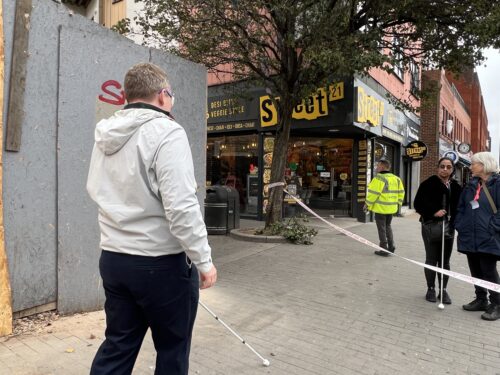Hounslow Council steps into the shoes of blind and partially sighted residents
London Sight Loss Councils (SLCs) has led a guided walk using special glasses that simulate eye conditions with representatives from Hounslow Council through Hounslow town centre. With over 6,400 residents in Hounslow registered as blind or partially sighted, the experience offered council staff a powerful, first-hand perspective on the impact of street obstacles, and is already informing plans to make local streets more accessible.
Learning through lived experience
London SLC began the session – held on 15 October – by introducing different types of visual impairment, inclusive design principles and sighted-guide techniques. Councillor Dunne, Cabinet Member for Climate, Environment and Transport joined staff members from transport, planning, licensing, highways and equalities teams at Hounslow Council – encountering a range of real-world obstacles and scenarios – from market stalls and street furniture to cycle lanes and informal crossings.
Hounslow Council shared that its aim was to capture insights that can feed into the Council’s planning, licensing, infrastructure and maintenance practices. Feedback from attendees captured by SLCs was extremely positive.

Sight Loss Council volunteers and Hounslow Council representatives stood on a pavement. There are street obstacles to the left.
Seeing public spaces differently
Councillor Katherine Dunne shared:
“Walking in someone else’s shoes was a powerful reminder of how small details make a big difference. This session has reinforced why inclusive design is not optional, but essential. We will use what we have learned to improve how we plan, design and manage our streets.
“We would like to thank the staff and volunteers at Thomas Pocklington Trust and London Sight Loss Council for the insightful workshop, and we look forward to delivering a borough that is safer and more accessible for all.”

Councillor Dunne (pictured left on the front row and wearing a red jacket) guides a Council representative who is wearing sim specs down a local street.
Councillor Ajmer Grewal, Cabinet Member for Residents Support, Communities and Equalities, added:
“Our equalities networks have long championed involving lived experience: this walk brings that to life. Along with feedback from residents affected, we will work with London Sight Loss Council to shape Hounslow’s streets, so they work for everyone.”
Amrit, a Hounslow resident and Sight Loss Council volunteer, said:
“As a blind resident, I want the pavements to be as clutter free as possible so that I can walk more freely – whether I am being guided or not. I want to be independent, but more importantly I want to feel safe when out in my community.
I hope that by taking part in the sim-spec walk, the attendees will have experienced first-hand, some of the many barriers we face in accessing our high street. I hope that they will use this learning to make Hounslow more accessible for blind and partially sighted residents.”
Nicki Guy, Senior Engagement Manager for Thomas Pocklington Trust, added:
“It was great to host a sim-spec walk with Hounslow Council’s Transport, Planning and Equalities teams. These sessions are such a valuable way to experience first-hand the daily challenges faced by blind and partially sighted people when getting around our streets – from street clutter to abandoned e-bikes and uneven paving.
“We really welcome Hounslow Council’s enthusiasm and commitment to inclusive design, and look forward to continuing our collaboration to make the borough’s public spaces safer, more accessible, and welcoming for everyone.”
How is this session influencing improvements?
Insights from the Sight Loss Council guided walk are already shaping improvements at Hounslow Council. This includes:
- designing more accessible EV charging, e-bike and kerbside layouts.
- making street furniture, paving and signage safer and easier to navigate.
- improving licensing, road safety and maintenance through inclusive design.

Zahra Ali, Senior Strategic Transport Planner at Hounslow Council, wearing sim specs and using a navigation cane.
Hounslow Council reports that the walk supports the Council’s existing commitments around accessibility, set out in its Transport Strategy and Walking and Wheeling Action Plan. This includes the Pavement Pledge programme, which began in July 2025 and is working to improve 20 footways across the borough.
The programme aims to provide residents with safer and more accessible routes. It also builds on the Council’s ongoing work with local equalities networks. This includes the Disability and Age Equality Partnership, whose members participated in a mobility focused audit in 2024.

A taped-off area blocks the path of a Hounslow Council representative. He is wearing sim specs and navigating using a cane.
Publication date: 28 October 2025

